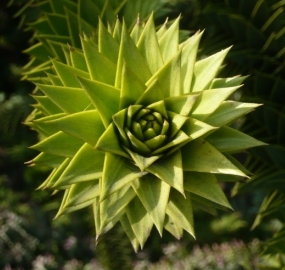Monkey Puzzle Tree
This is the end of a branch can you tell what tree it is from? Well not much of a puzzle to monkey around with. With sharp edged and pointed leaves of the Monkey Puzzle Tree would impale and slice the most careful monkey that was trying to climb its branches.
Facts about Monkey Puzzle Trees
- It grows slowly when young and picks up speed when older. It can reach 120 feet tall and become quite wide so isn’t a long term proposition for a small garden.
- It can’t be pruned successfully as its sculptural shape is the key reason for growing the tree.
- It is usually ‘dioecious’ with the male and female cones on separate trees. It takes many years upto 40 before it bears cones
- In its native Chile the seeds are eaten as a crop
- It prefers well drained slightly acidic volcanic soil but will tolerate almost any soil type with good drainage is good.
- Araucaria araucana is the Monkey Puzzles Tree’s Latin name but due to of the species’ great age it is sometimes described as a living fossil.
- The common name Monkey Puzzle Tree comes from ‘Archibald Menzies in the 1800’s, who thought it would certainly be a puzzle for a monkey to climb. One night, Mr. Menzies was dining out in Chile. Unable to identify some nuts on the table, he popped a few in his pocket. A number of them sprouted on the voyage home. In this manner, Araucaria araucana, or Monkey Puzzle Tree found its way into the rare plant collections of 18th century Europe!’

2 thoughts on “Monkey Puzzle Tree”
Our Monkey Puzzle tree which is about 20ft tall has started to develop cones. The tree which was planted about 12 years ago. How do we know if it is male or female? If it is female and there is a male tree nearby how do we pollinate it, or should we try?
We haver an •Araucaria tree indoors . It’s about 2 metres high and seems to have a period of time when it’s spiky leaves drop off. Is this natural and should this tree really be outside?
Comments are closed.